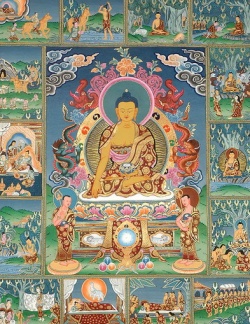Brief Background of the Shamarpa Lineage
Bodhi Path Buddhist Centers are founded and directed by Shamar Rinpoche, who, along with the Gyalwa Karmapa, is the current holder of the Karma Kagyu lineage. Shamar Rinpoche is the 14th Shamarpa, or Red Hat Lama of Tibet. For a brief bio of the 14th Shamar Rinpoche, see here.
The Shamarpas are the second-oldest reincarnate lineage. As with any reincarnate lineage, what earlier incarnations have done or not done does not define the subsequent Shamarpas. The current Shamarpa has said, "Since every incarnation is a new life, credit from great deeds in the past is not transferred automatically to each new incarnation. Likewise, one cannot blame any reincarnate Lama for not being as great as his or her previous incarnation. Boys or girls are recognized as tulkus at a young age, placed in monasteries and given a tremendous amount of responsibility. They do not choose this life for themselves. This is true of every Tibetan reincarnate lineage. Greatness must be earned anew in each life."
Many of the Shamarpas were great scholars. In particular, the 1st Shamarpa Khedrup Trakpa Senge (1284-1349), 2nd Shamarpa Kachö Wangpo (1350-1405), 3rd Shamarpa Chöpel Yeshe (1406-1452), 4th Shamarpa Chökyi Trakpa Pal Yeshe (1453 -1526), 5th Shamarpa Könchog Yenlag, (1526-1583), 6th Shamarpa Chökyi Wangchuk, (1584-1629), 8th Shamarpa Palchen Chökyi Döndrup, (1695-1732) and 10th Shamarpa Chödrup Gyatso (1742-1792), stand out in terms of their intellectual contributions. The 4th Shamarpa even ruled Tibet for 12 years towards the end of his life.
The history of the Shamarpas becomes especially dramatic during and after the lifetime of the 10th Shamarpa, Chödrup Gyatso (1642-1692). For that reason it is useful to explain his life in more detail here. The 10th Shamarpa was a brother to the 3rd Panchen Lama Palden Yeshe (1738-1780), a highly ranked Gelukpa Lama. The 10th Shamarpa had a very poor relationship with the Gelukpa government of Tibet that was based in Lhasa and directly ruled by the Chinese Emperor Qianlong (1711-1799). Tsomonling Ngawang Tsultrim, the imperial Chinese representative in Lhasa at that time, was especially opposed to him for a number of reasons. First of all, he belonged to the Karma Kagyu school and claimed that that the Kagyus were the former rulers of Tibet. Second, he was on friendly terms with the British government in India, a state of affairs that had come about because his mother was a princess of Ladakh. Both of these facts made the Emperor's government very suspicious. Fearing censure or punishment from the governments of both Tibet and China, the 10th Shamarpa fled to Nepal. He lived there comfortably until, in 1788, a war broke out between Tibet and Nepal over the minting and circulation of counterfeit coins. The 10th Shamarpa was used by the government of Nepal as a mediator in the peace talks with Tibet, and as a result the government of Tibet informed the Emperor Qianlong that the Shamarpa had taken the side of the Nepalese in the conflict. The Gelukpa Tibetan government then requested that the Shamarpa institution be banned. The ban was effected upon the death of the 10th Shamarpa in 1792 and remained in effect until the 20th century.
From 1792 until 1963, no Shamarpa reincarnation was enthroned, although the 11th, 12th, and 13th Shamarpas were secretly recognized during that time by the Karmapas. In 1963, the 14th Dalai Lama and the 16th Gyalwa Karmapa formally restored the institution of the Shamarpas, enthroning the current 14th Shamarpa.
